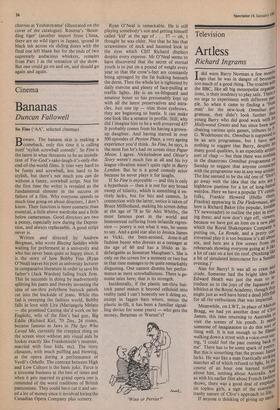Art
More splendours
John McEwen
The Great Japan Exhibition: Art of the Edo Period 1600-1868 — unmatched since 1910 and to be seen nowhere but here (least of all in Japan where they do not display art with the same abandon as we do in the West) — had the majority of its most important objects replaced over Christmas by others of equal standing, and so now enters its second and final phase (Royal Academy till 21 February). An attendance of approximately 300,000 was recorded for the first part, and this has to be matched in the second if the Academy, perennially short of funds, is to be profited. A loss is underwritten, but if ever the institution deserved reward it is for laying on this feast of a show. At present the effect of the weather is causing some anxiety, but this may well be counter-balanced by an even greater rush of crow& as time runs out in February. Now is an ideal moment to go or go again.
The layout and immaculate presentation of the rooms and objects is unchanged, but the number and quality of the replacements nevertheless ensures that this is virtually a new exhibition. Sword handles and scab- bards constitute one of the most glamorous of the new sections. The show in general reflects the political influence of the time passing from warriors to merchants; a tran- sition marked, broadly, by the passage from simplicity to complexity and embellishment in design. The understate- ment of black and white remained the ultimate artistic refinement in the eyes of the aristocrat and the scholar-painter. This is perhaps most clearly demonstrated in the design of swords, as they change from being weapons to ornaments. Lacquer is the dominant surface of sword mountings throughout the period, but there is 200 years' difference of menace between that of the 16th century, wrapped against damage
The substance of Alfred Alexander's ar- ticle, 'The voice and the singer', printed in the previous issue, will appear in the Yehudi Menuhin guide, The Voice, to be published by Macdonald in 1983.
from armour for a third of the scabbard, and the untrammelled scarlet and dark green stripes of the 18th. Nevertheless, a lack of battles was not allowed as an excuse for the sword blade to be any less efficient; 17th-century smiths, for instance, commis- sioned specialist sword tests. Exhibit 247 has the grisly inscription on its blade: `Made and engraved by Nagasone Okisato: cut through two bodies, Yamano Kaemon Nagahisa; cut through three bodies, Yamano Kanjuro Naganari; tested many times on one body . . .'. The Yamano fami- ly were apparently pre-eminent in this rather sinister profession.
The kimonos, too, seem more dazzling than before, even if fewer are as startlingly asymmetric in their decoration. Initially derived from a lowly undergarment, the kimono found its most sumptuous expres- sion as the costume of NO theatre. Because of the importance of arm movements in No, a great variety of sleeves evolved and a further elaboration and classification of robes by shape. This in turn led to a greater variety and extravagance in the design and ornament of everyday kimonos. The lack of cut made kimonos ideal clothes for overall decoration. The influence of dress-fabric design was felt in all the other arts of Japan, and the materials were important in such things as the mounting of scroll-paintings. The designers appear to have incorporated every aspect of daily life into their motifs, not just flowers and clouds and rivers but, in the present selection, 'hanging columns of straw hats and fans', books and even bats. Eventually the designs became so complicated they amounted to nothing more than transferred pictures. This sig- nalled the decline of textile art.
Japanese painting, like virtually everything else in Japanese culture, derives from China. The chief subject of secular painting in this anti-religious era is land- scape. Humans appear but in no form of Japanese painting are they the centre of in- terest. Even Utamaro's actresses and courtesans of 'the floating world' of the ci- ty of Edo towards the end of the period are more fashion-plates than character studies. It should also be recognised that perspective — except in some late instances of Western influence — is vertical: that is, the higher up the picture, the further away the object depicted. In this convention gaps, of necessity, indicate distance. A brilliant in- novation of the Japanese painter Eitoku was to turn these spaces into a much more flexible device by painting them as a gold leaf background. Blank areas could thus be used to break up the design at will in forms suggestive of mountains, mists and clouds. This invention became a commonplace device. There is also no use of light and shade in Japanese art, and thus almost no celebration of sunlight. The moon by day is • a favourite theme precisely because it casts no shadows. Hoitsu's 'Moon with autumn flowers' is a marvellous example. Screens, by staggering an image, augment rhythm. A wonderful example of that is provided by the bounding hills of Shiko's 'Flowering cherries at Yoshinoyama' (illustrated on the cover of the catalogue). Rosetsu's 'Boun- ding tiger' (another import from China, there are no wild tigers in Japan), spread in black ink across six sliding doors with the final one left blank but for the ends of two supremely audacious whiskers, remains from Part 1 as the sensation of the show. But one could go on and on, and should go again and again.



































 Previous page
Previous page